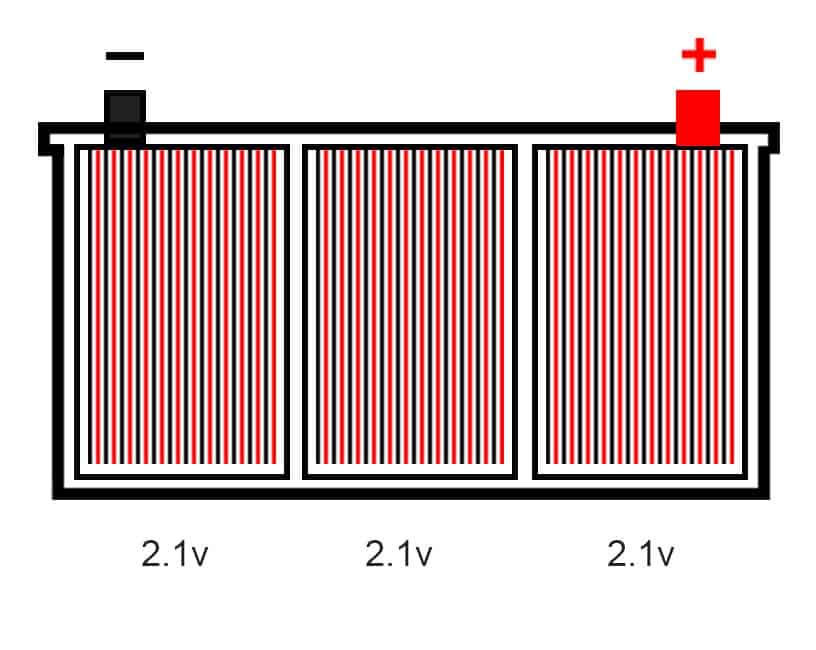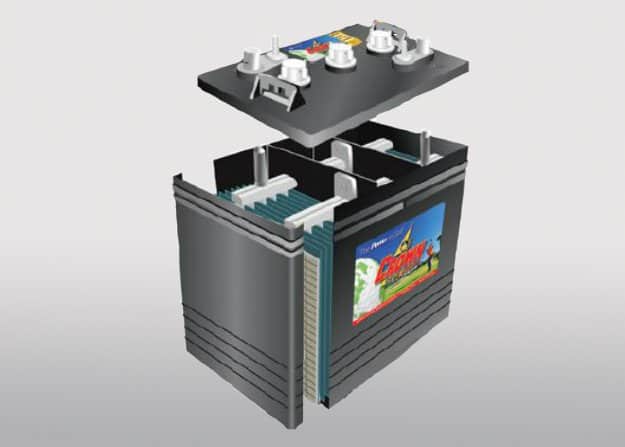Last Updated on February 14, 2024 by Chuck Wilson
Golf cart batteries going bad? How do you test the battery in a golf cart? You can easily run preliminary tests on your batteries using either a voltmeter or a hydrometer. Here we will discuss the procedures.
If your electric golf cart isn’t going as far on a full charge anymore, or begins to “shutter”, this could indicate a problem with one or more of the batteries.
How To Test Golf Cart Batteries – Four Methods
Always test fully charged batteries at room temperature.
Testing Golf Cart Batteries With A Multimeter
Testing golf cart batteries with a multimeter involves fully charging the cart’s battery rack, then using the multimeter (Set it to 200v DC)across the posts of each individual battery. You can do this without disconnecting the batteries from each other as long as you test across one battery’s posts. On a 6-volt battery, you should have slightly over 6 volts, like 6.1 to 6.3. If you get a reading of something like 4.1, then one of the cells in this unit is bad or shorted.
Testing Golf Cart Batteries With A Hydrometer
Testing golf cart batteries with a hydrometer measures the specific gravity of each cell. These are inexpensive and can be purchased at most automotive parts stores.
Plain water is the baseline for measurement and has a gravity of 1.000. A fully charged battery will have a concentration of sulfuric acid to water of 1.280, while a discharged battery will test out at about 1.145.
Draw electrolyte into the hydrometer several times to allow the thermometer to adjust to the temperature of electrolyte and note the reading. Observe also the electrolyte color. A gray or brown coloration shows that the end of your battery life is nearing.
Hold the hydrometer vertically at eye level and take note of the reading where the scale of the float meets the electrolyte.
Check each cell in the battery and write down the results. Compare the numbers when you complete the tests. A disparity of 50 points of reading between any two cells is an indication of a problem with the cells showing the low reading.
The instructions that come packaged with your hydrometer will be more accurate for your brand and should be used when taking readings.
Testing Golf Cart Batteries With Load Testing
Testing golf cart batteries with load testing will give you more insight as to the health of your battery. By putting a dummy load on the battery, you can see how the battery performs when actually being used. The load tester hooks to the terminals of the battery and displays the voltage. By pressing a button on the tester, a resistor is brought into the circuit and puts a load on the battery. A healthy battery will only drop in the voltage by about .2 to .4 volts. More than this indicates a possibly faulty or failing battery.
Testing Golf Cart Batteries With Discharge Testing
Testing golf cart batteries with discharge testing is an expensive way to go. The equipment has an average price of $1,200. Unless you are a repair shop (I’m going to assume you aren’t or you would already know all of this) then it probably isn’t worth it to add one to your garage.
This unit is hooked up across the whole bank of batteries and will put them under a resistance load. After a few minutes, it will tell you based on the rate of decay how long your cart could run before ¾ of the charge is depleted.
How Much Does It Cost To Replace The Batteries In A Golf Cart?
The cost of replacing the battery pack typically runs from $800 to $1500 depending on the number of batteries needed and the brand you go with.
What Is The Best Golf Cart Battery?
The best golf cart battery is the Trojan T-105 battery, in our opinion. They are the best-known premium battery and have nearly 100 years of manufacturing experience. Trojan Battery Company was founded in 1925 and developed the golf cart battery for the Autoette in 1952. The distinctive maroon color of the T-105 makes it easy to distinguish from its competitors.
Golf Cart Batteries and Safety
Before performing any of these tests, you need to protect yourself from acid splashing or (in the extreme) battery explosion due to gas igniting from a spark. Long sleeves, long pants, gloves, and protective eyewear are a must. I would even have a fire extinguisher handy, just in case.
There are different types of batteries used in newer style golf carts (Absorbed Glass Mat, Lithium, Gel) that require different testing procedures. For this article, we will be testing flooded cell lead-acid batteries, commonly used in gas and electric golf carts, electric vehicles, and utility vehicles. Other battery types require procedures different from those outlined here for lead-acid varieties.
Are Electric Golf Cart Batteries Deep-Cycle?
Yes, a deep-cycle battery is a battery that is regularly deeply discharged (using most of its charge over a period of time), therefore needing a longer period of charging. An example of a non-deep-cycle battery would be a regular car battery which would be used for a short burst of high-amperage cranking before being recharged. This uses only a small part of its capacity and the battery is recharged as the engine runs.
What is a Battery? Basics 101
What is a battery? It sounds like a dumb question, but many incorrectly assume that a golf cart battery is a storage device. In fact, a battery produces electricity through a chemical reaction.
A brief description of a lead-acid battery is a container with two dissimilar metals immersed in acid to produce a chemical reaction. This reaction produces chemical energy in the form of electrical energy.
The acid (or better known as electrolyte) in a battery is a solution of water and hydrosulphuric acid mixed to a specific gravity. Charging and discharging measurably changes the specific gravity of the electrolyte. Some of the liquid will be lost a little at a time during this process due to gassing which is why we should closely observe electrolyte levels.
Batteries of this type have separate banks with a potential of 2.1 volts per bank. How many volts is your battery? Count the number of fill caps and multiply times 2.1.

Symptoms of a failing battery or batteries could include the following:
- You may notice the range decreasing over time. The range should be about 2 rounds of golf.
- A “Shutter” is when the cart feels like you are running across a corduroy road or someone is tapping the brake in a rapid staccato. This is a classic sign of low voltage. If this is experienced, your cart may be low on charge, the charger may not be functioning properly or you may have a battery issue.
- On electric golf carts, the cart refusing to move at all on a charged set of batteries could be the controller not engaging when the voltage falls below a preset value.
- It takes twice as long to charge your batteries as it did when you first had them installed. As the batteries age, they will not hold a charge as well as they used to. The charger has no way to know this and will continue to charge the batteries trying to get to a full charge – meaning it will take longer to charge the batteries than normal.
How Long Do Batteries Last In A Golf Cart?
4-6 years is the average life of a battery. Simply put, after a few years the plates lose enough substance to stop working properly. If you are unsure of the age of your battery, check the labeling on the top or look at the stamp on the battery post. The first letter is the month (A=January, B=February, etc.) and the following number is the year. If it was a 5, for example, you can bet it wasn’t 2005…batteries don’t last that long.
Tips For Maximizing Battery Life
- Shallow discharges will result in longer battery life. Lead-acid batteries do not develop a memory like rechargeable NiCads and do not need to be fully discharged before recharging.
- Use your golf cart and batteries often…avoid long periods of storage.
- 50% (or less) discharges are recommended. 80% discharge is the maximum safe discharge.
- Do not fully discharge lead-acid batteries (80% or more). This will damage (or kill) the battery.
- Do not leave batteries discharged for any length of time.
- Batteries should be charged after each use.
- If your charger does not have an automatic cut off for a fully charged cart, then be sure to not overcharge and boil the batteries. This will shorten battery life considerably.
- Do not charge frozen batteries.
- Keep a record of the condition of each battery and refer to your notes frequently.
- Keep each battery as clean as possible…use a stiff brush and remove any corrosion from the terminals and mud or dirt off the top of the battery.
- Remove the terminal connector and clean the post and the inside of the connector…poor contact causes arcing and heat which will melt the lead used in these components.
- Corrosion on the battery terminals can be lessened or eliminated by installing battery covers. (most of the corrosion is caused by the gases produced during charging.)
Here is a quick note on the Battery De-Sulfater and Battery De-Mister. Thermoil has a product (De-Mister) that, when added, floats on the surface of the electrolyte fluid and reduces water consumption and corrosion. The De-Sulfater can restore and preserve the plates in new and used batteries. Details on this product can be found at https://www.Thermoil.com
I am not a sponsor of this product, nor have I tested it, but the biggest expense you are going to get with your electric cart is the batteries. The longer you can keep them in top shape, the better for your pocketbook.
Battery Chargers and General Practices
The state of charge or discharge golf batteries are in at the end of the day depends upon the type of play and the number of holes the golf cart was used for. The battery charger is designed to bring a normally discharged battery back to full or nearly full charge in a given time. When charging, allow enough time for a complete charge cycle.
Where golf cars are used hard for 36 holes a day and possibly more than that on some days, there’s a good chance that the charger cannot keep up with the amount being discharged from the battery. When this happens, the batteries start remaining in a low state of charge. The charger could be working fine but if you don’t get the cart on the charger until late at night, and take off early in the morning, there’s a pretty good chance that they are not getting a full charge.
The average just discharge rate is around 75 amperes and if the cart is used for 36 holes pedal-down time of around 70 minutes, approximately 90 ampere-hours will be removed from the battery. To recharge, the batteries will require 90 ampere-hours + 20% to make up for any charge deficiency. This means about 108 ampere-hours of charge. If the batteries are only given the average 90 to 99 ampere-hours, then you can see how the charge would fall behind after a week, making it appear that the batteries are bad.
In such cases where carts are used hard and they start falling behind, it may be prudent to apply what is called a “catch up charge”. Simply put, on an off day when the cart is not in use, use the hydrometer to take a reading on the charge state and use the following chart to determine how many hours are needed to “catch up”.
| Catch Up Charge Required | |
|---|---|
| State of Charge | Charge Time |
| 1.260 to 1.280 Specific Gravity | None |
| 1.240 to 1.260 Specific Gravity | 4 Hours |
| 1.220 to 1.240 Specific Gravity | 8 Hours |
| Below 1.220 Specific Gravity | 12 Hours |
Equalizing (For Flooded Batteries Only)
Equalizing is performed on batteries that have become over-sulfated and are less effective as they get older. The process is accomplished by putting a controlled overcharge across the battery plates to desulfate them. Battery plates collect sulfate over time that interferes with the chemical reaction between the electrolyte and the outer layer. This controlled overcharging essentially dislodges the sulfate coating and increases the reactive surface available to the electrolyte. The action also causes a controlled boiling which mixes the acid for better distribution throughout the cell. These are the steps for equalizing your batteries:
- Verify that the batteries are fully charged.
- Disconnect any loads from the battery bank to protect any sensitive electronic components.
- Remove all the hydro caps from the cells.
- Set your charger to “Equalizing” voltage (15.5 volts for a 12-volt bank). If your charger is not equipped with an equalizing voltage setting, unplug the charger, wait a moment, and then plug it back in again. This will also initiate the equalizing charge.
- The batteries should begin gassing and bubbling.
- Keep the battery temperature between 115 degrees and 125 degrees. Take this measurement from the center cell.
- Measure the specific gravity every hour.
- When the specific gravity stops rising, then equalization is complete.
Why would my battery go bad?
As mentioned earlier, the electrolyte level must be kept at optimum levels or damage can be done to the plates inside. Incorrectly watering is the major cause of problems in batteries.
Using tap water instead of distilled water introduces impurities that can eventually build hardened deposits that bridge across and short out plates.
Over-watering is usually when water is added BEFORE charging the batteries. When charging the battery, the electrolyte solution expands, leaks out through the top vents and damages contacts and cart frames, not to mention the garage floor. The only exception to adding water to discharged batteries is if the water is below the top of the plates. In this instance, you would add just enough to cover the plates, charge fully, then add water to the proper level.
Under-watering can cause a sulfate film to form on the exposed portion of the plate which will, when the electrolyte is back to the proper level, inhibit the chemical exchange.
For future protection of your batteries…install an Amp Hour Meter
An excellent addition to your cart would be an Amp Hour Meter installed in the dashboard. The smart meters keep historical data and can prevent trouble with your battery bank by calculating the battery efficiency. These can tell when to perform an equalization, or let you know when your batteries have reached the 85% end-of-life cycle. An example of one of these meters is the Victron Bluetooth-capable model. Check out the meter options here.
Final Note
Lead-acid batteries will self-discharge 5% to 15% per month, depending on the temperature of the storage conditions.
If you store your batteries for an extended period of time, be sure to charge them fully every 3 to 6 months.







